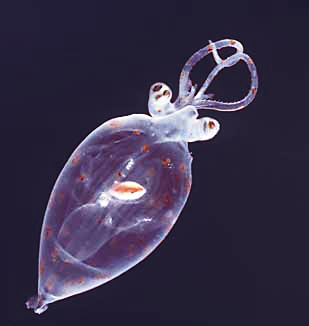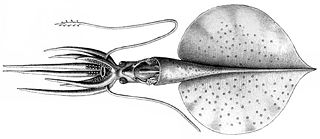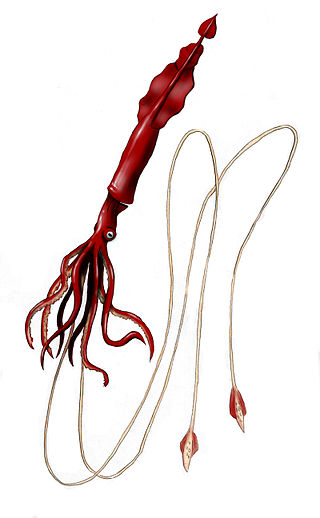
Loliginidae, commonly known as pencil squids, is an aquatic family of squid classified in the order Myopsida.

The Mastigoteuthidae, also known as whip-lash squid, are a family of small deep-sea squid. Approximately 20 known species in six genera are represented, with members found in both the mesopelagic and bathypelagic zone of most oceans. Originally described by Verill in 1881, it was later lowered by Chun (1920) to a subfamily (Mastigoteuthinae) of the Chiroteuthidae. However, Roper et al. (1969) raised it back to the family level, and this has not been changed since. The taxonomy of this family is extremely unstable, and there have been at times one genus, two genera and four subgenera(Salcedo-Vargas & Okutani, 1994), two genera and several 'groups', five genera and one species with an uncertain placement, or six genera.

The hooked squid, family Onychoteuthidae, currently comprise about 20–25 species, in six or seven genera. They range in mature mantle length from 7 cm to a suggested length of 2 m for the largest member, Onykia robusta. The family is characterised by the presence of hooks only on the tentacular clubs, a simple, straight, funnel–mantle locking apparatus, and a 'step' inside the jaw angle of the lower beak. With the exception of the Arctic Ocean, the family is found worldwide.

Bigfin squids are a group of rarely seen cephalopods with a distinctive morphology. They are placed in the genus Magnapinna and family Magnapinnidae. Although the family was described only from larval, paralarval, and juvenile specimens, numerous video observations of much larger squid with similar morphology are assumed to be adult specimens of the same family.

Myopsida is one of the four orders of squid. It consists of two families: the monotypic Australiteuthis and the diverse and commercially important Loliginidae. Some taxonomists classify this taxon as a suborder of the order Teuthida, in which case it is known as Myopsina. This reclassification is due to Myopsina and Oegopsina not being demonstrated to form a clade.

Decapodiformes is a superorder of Cephalopoda comprising all cephalopod species with ten limbs, specifically eight short arms and two long tentacles. It is hypothesized that the ancestral coleoid had five identical pairs of limbs, and that one branch of descendants evolved a modified arm pair IV to become the Decapodiformes, while another branch of descendants evolved and then eventually lost its arm pair II, becoming the Octopodiformes.

Magnapinna pacifica is a species of bigfin squid known only from three immature specimens; two caught at a depth of less than 300 m (980 ft) and one from a fish stomach. M. pacifica is the type species of the genus Magnapinna. It is characterised primarily by its proximal tentacles, which are wider than adjacent arms and bear numerous suckers.

Magnapinna talismani is a species of bigfin squid known only from a single damaged specimen. It is characterised by small white nodules present on the ventral surface of its fins.
Echinoteuthis danae is a species of whip-lash squid. Known only from specimens of paralarvae, the species may be the juvenile form of Echinoteuthis atlantica.
Mastigoteuthis is a genus of whip-lash squid containing at least seven valid species. Some teuthologists consider Idioteuthis synonymous with this taxon.

Mastigoteuthis agassizii is a species of whip-lash squid. It is the type species of the genus.

Echinoteuthis atlantica is a species of whip-lash squid from the family Mastigoteuthidae. It occurs in the eastern North and South Atlantic Ocean. This squid is red in colour and similar to Echinoteuthis famelica of the Pacific but differs in having a well developed protective membrane on the tentacular club which is absent on E. famelica. The presence on this membrane on Echinoteuthis glaukopis from the Indian Ocean suggests that this may be a synonym of E. atlantica, in which case glaukopis has priority.
Mastigoteuthis inermis is a species of whip-lash squid. Richard E. Young and Michael Vecchione consider it to be a junior synonym of the widely distributed M. magna.

Asperoteuthis is a genus of chiroteuthid squid comprising four species:

Magnoteuthis microlucens is a species of squid; the most common species of Mastigoteuthis around the main Hawaiian Islands.

Cephalopod fins, sometimes known as wings, are paired flap-like locomotory appendages. They are found in ten-limbed cephalopods as well as in the eight-limbed cirrate octopuses and vampire squid. Many extinct cephalopod groups also possessed fins. Nautiluses and the more familiar incirrate octopuses lack swimming fins. An extreme development of the cephalopod fin is seen in the bigfin squid of the family Magnapinnidae.

Cephalopods exhibit various dermal structures on their mantles and other parts. These may take the form of conspicuous warts, cushions, papillae or scales, though in many species they are microscopic tubercles. The most elaborate forms are found among the oceanic squid of the order Teuthida.
Mastigotragus is a genus of whip-lash squid containing a single species, Mastigotragus pyrodes. This species was originally placed within Mastigoteuthis, but has been subsequently separated from other species in that genus due to multiple morphological characters. This genus is characterized by a lack of antitragus in the funnel-locking cartilage, larger sucker rings on the tentacles, a particular photophore morphology, and relatively large eyelid photophore. This genus is Latin for 'whip-lash goat'.
Richard E. Young is a teuthologist. He is an Emeritus Professor of Oceanography at the University of Hawaii's School of Ocean and Earth Science and Technology.

Chiroteuthoidea is a superfamily of squid in the order Oegopsida. They are the sister group to the Pholidoteuthoidea.















